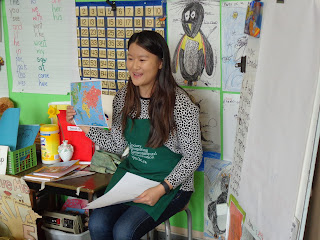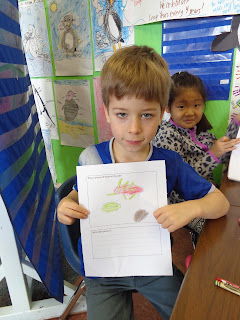Global Hunger Workshop with Bayview Elementary
By Amy Ing
On March 2nd, I had the pleasure to present a hunger workshop to Ms. Taylor's 24 students, Grade 1 class. The purpose of this workshop was to engage students in learning about how hunger varies across the world, and ways as a class we can do to help solve world hunger.
First, students were asked to describe what is hunger. Common responses were, 'when people do not have enough food and lack money to buy food' and 'when people do not eat in a day.' A student even described how hunger impacts the acidity in our stomach and how people may get sick from being hungry. Students also shared stories about their encounters with helping people suffering from hunger by donating food or giving them money.
Next, students were split into four different groups representing four countries: Indonesia, Mexico, Canada and Morocco. Each student in the group had to locate where their representative country was located on the map. I was amazed how easy these students found their country!
Students locating where Mexico is. Bueno!
Then the students completed a two part worksheet. Part 1 consisted of drawing the foods commonly grown and consumed in their respective countries while also describing the jar of water on their table. Look at the amazing illustrations by these talented artists below!
The food items identified in each of the countries are as follows:
Students were asked what ways as a class or individually can we help solve local hunger? Some of the student responses were:
Part 2 of the worksheet was a reflection on what the students learned. Each student wrote a sentence or two about an important aspect they learned in the workshop. Some of the key things students learned were, "Indonesia grows dragonfruit and starfruit", "Indonesia, Mexico and Morocco have dirty water compared to Canada" and "hunger was more than not having enough food, but a lack of variety." Below you will find testimonials from our workshop.
After the workshop, students got to have some yummy Easter cookies and treats from their foods on their table as a thank you for their participation and their generous donation of 42 pounds of food to the Greater Vancouver Food Bank Society!! A special thank you to all the families and students in Ms. Taylor's class!! Way to go!
On March 2nd, I had the pleasure to present a hunger workshop to Ms. Taylor's 24 students, Grade 1 class. The purpose of this workshop was to engage students in learning about how hunger varies across the world, and ways as a class we can do to help solve world hunger.
First, students were asked to describe what is hunger. Common responses were, 'when people do not have enough food and lack money to buy food' and 'when people do not eat in a day.' A student even described how hunger impacts the acidity in our stomach and how people may get sick from being hungry. Students also shared stories about their encounters with helping people suffering from hunger by donating food or giving them money.
Next, students were split into four different groups representing four countries: Indonesia, Mexico, Canada and Morocco. Each student in the group had to locate where their representative country was located on the map. I was amazed how easy these students found their country!
I was delivering the instructions to the class before the workshop.
Students locating where Mexico is. Bueno!
Then the students completed a two part worksheet. Part 1 consisted of drawing the foods commonly grown and consumed in their respective countries while also describing the jar of water on their table. Look at the amazing illustrations by these talented artists below!
The food items identified in each of the countries are as follows:
- Morocco-couscous and rice
- Indonesia-dragonfruit, starfruit and rice
- Canada-vegetable fruit tray containing carrots, celery, tomatoes and broccoli, granola bars, Twizzlers and rice
- Mexico-hummus, tortilla chips, rice and tacos
Students were asked what ways as a class or individually can we help solve local hunger? Some of the student responses were:
- "finish all of our lunches today so no food goes to waste"
- "donate food to local food banks"- this was actually done by the students and families to the Greater Vancouver Food Bank in East Vancouver
- "share food with other countries" (this part was actually demonstrated in class with students delegating which food item in countries Canada, Mexico and Indonesia would share/'donate' to Morocco)
- "grow food in the [school] garden"
Part 2 of the worksheet was a reflection on what the students learned. Each student wrote a sentence or two about an important aspect they learned in the workshop. Some of the key things students learned were, "Indonesia grows dragonfruit and starfruit", "Indonesia, Mexico and Morocco have dirty water compared to Canada" and "hunger was more than not having enough food, but a lack of variety." Below you will find testimonials from our workshop.
After the workshop, students got to have some yummy Easter cookies and treats from their foods on their table as a thank you for their participation and their generous donation of 42 pounds of food to the Greater Vancouver Food Bank Society!! A special thank you to all the families and students in Ms. Taylor's class!! Way to go!
A grand total of 27 canned goods, 2 jars of pasta sauce, 6 bags of pasta, 30 mini packets of hot chocolate and 1 box of oatmeal were donated to East Vancouver.
A receipt from the Greater Vancouver Food Bank Society of our donation!












